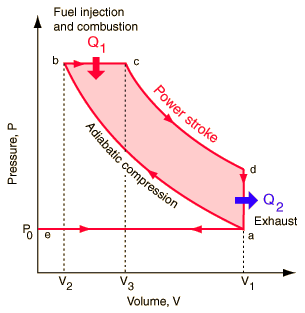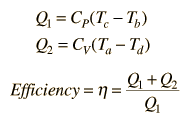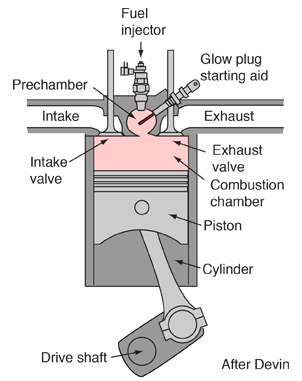The Diesel Engine
The diesel internal combustion engine differs from the gasoline powered Otto cycle by using a higher compression of the fuel to ignite the fuel rather than using a spark plug ("compression ignition" rather than "spark ignition").
 |
In the diesel engine, air is compressed adiabatically with a compression ratio typically between 15 and 20. This compression raises the temperature to the ignition temperature of the fuel mixture which is formed by injecting fuel once the air is compressed. The ideal air-standard cycle is modeled as a reversible adiabatic compression followed by a constant pressure combustion process, then an adiabatic expansion as a power stroke and an isovolumetric exhaust. A new air charge is taken in at the end of the exhaust, as indicated by the processes a-e-a on the diagram. |
|
Since the compression and power strokes of this idealized cycle are adiabatic, the efficiency can be calculated from the constant pressure and constant volume processes. The input and output energies and the efficiency can be calculated from the temperatures and specific heats:  |
 |
It is convenient to express this efficiency in terms of the compression ratio rC = V1/V2 and the expansion ratio rE = V1/V3. The efficiency can be written

and this can be rearranged to the form
 |
|
For an air standard engine with γ = 1.4 , compression ratio rC = 15 and expansion ratio rE = 5, this gives an ideal diesel efficiency of 56%.
The diesel cycle depends upon this temperature being high enough to ignite the fuel when it is injected.
*psig is pounds per square inch gauge pressure. Common pressure gauges in the U.S. measure pounds per square inch excess over atmospheric pressure.
| More details about the diesel cycle |
Heat engine concepts
Reference
Devins
Ch 4
| HyperPhysics***** Thermodynamics | R Nave |






